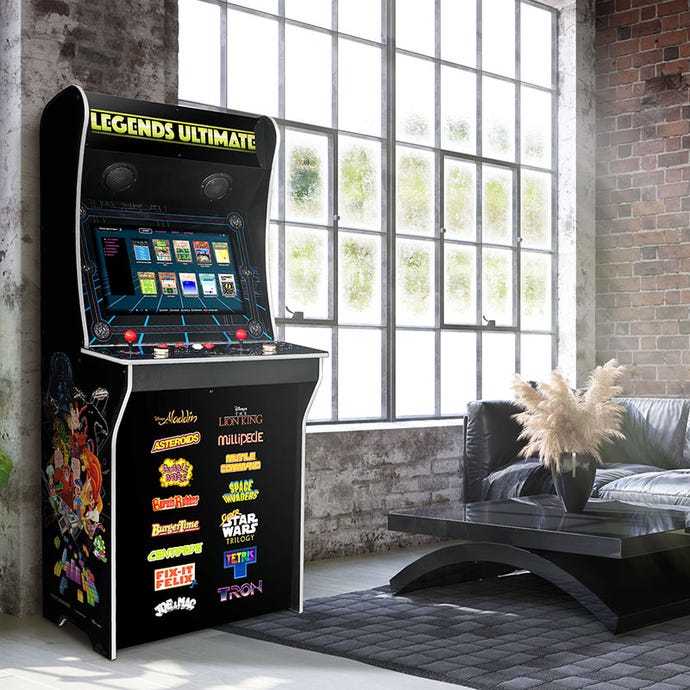The home arcade scene is enjoying a lockdown-driven surge
At least this has come out of the hell year.
This last year has sucked - lockdowns, restrictions, and the general challenges of adjusting to a vastly different status quo have been difficult for many of us. Equally, it’s been an opportunity to explore different things you can do at home - and for many that has meant a whole lot of video games.
I’ve seen this across the industry, in casual gamer friends, and even in my own habits. I’ve probably got through more backlog games in the year-and-a-bit since the UK’s first lockdown in March 2020 than in the entire two or three years’ previous. This job usually just doesn’t allow backlog antics; it’s always onto the next thing. I’ve even gone back and played some old favorites, refreshing myself on Final Fantasies 7 and 8, with a plan to pick off 9, the best one, in the coming weeks.
But there’s one other exciting trend I’ve seen on an upswing throughout the pandemic: people embracing home arcade action.
This shouldn’t surprise, really. Over the past year, I’ve seen numerous news stories in the local press about industrious (and, obviously, monied) families who have erected fully-featured bars in their gardens as a way to stave off the lockdown boredom and create a little of the pub atmosphere. The excellent Philips PerfectDraft machine, a draft beer dispenser that can help give some of that pub feeling at home, has been trapped in low-stock, waiting-list hell that makes trying to track down a PS5 look tame since restrictions began. That’s the drinkers’ version. For video games, what is more lavish, and equivalent, than an arcade cabinet?
Now, admittedly, I was on this train for a while before lockdown - so perhaps I’m biased. But that interest has also placed me in an interesting position of already being a part of certain arcade collector, builder and modder communities - and I’ve seen them all swell with activity as bored folk look for something novel to use at home.
The options have never been better, too. The old fashioned way was simply trawling auctions and close-knit communities to find an original cabinet up for sale; and to an extent, that’s still where a lot of the best action is. But those not willing to take on the burden of an ancient cabinet with all the classic car style upkeep involved now have a slew of new options, with burgeoning companies eagerly filling the market’s demand.
If you’re a little more confident, one popular route now is to pick up a flat-pack cabinet and then fill and decorate it yourself. A few years ago if you wanted to ‘self build’ a custom cabinet you’d need to be skilled with woodwork and do everything yourself - this was how I built my first machine. Now however, a range of companies produce IKEA style flat-pack arcade cabinets in every form factor you can imagine. Cocktail, bartop, free-standing, wall-mounted, three-quarter scale - if you search around, everything is out there. If you don’t have room for a machine at home, there’s even control panels you can order - build it up, drop technology inside, and then plug it into your TV for an arcade-style experience. It’s a clever idea.
With these, you can paint and finish the machine to your liking. You can also choose what to put in it - a Raspberry Pi, an old console, a Windows PC, whatever. For many platforms, brilliant front-ends like Attract Mode and LaunchBox make it so that when playing the arcade feeling is never interrupted by seeing windows or the like - the front-end can take care of everything. Consoles can work just as well, and can be an economical option. If you love fighting games and have just upgraded to a PS5, for instance, you can quite easily set one of these up and drop your old PS4 into it to play all of the previous generation’s fighters in a cabinet setting.
The other option is more immediately intriguing; licensed machines that come with all the technology and artwork, plus a bunch of pre-loaded games. Two companies stand out as leading the charge here: AtGames and Arcade1Up. Both of these companies are having great success with replica arcade machines, but they’re also both making moves around replica pinball tables, too. Since covid took home, demand seems to have skyrocketed, with both brands frequently sold out.
AtGames positions itself as the more premium of the two, and offers full-size and smaller cabinets as well as plug-and-play micro consoles with arcade controls. AtGames sets itself apart by offering one machine that has hundreds of licensed games. Wi-Fi connectivity even allows new games and updates to be downloaded, as well as leaderboards and the like.
These are all-in-one machines, with the smaller traditional cabinet costing $400 and the larger at over double that. These are a larger investment, and feel more designed for if you want one show-stopping machine to show off when you have guests. The game list is good, with some names - Asteroids, Tetris, Star Wars and the like - but it doesn’t have the arcade names like Street Fighter or Mortal Kombat.
That’s where Arcade1Up comes in. Its specialty is dedicated machines - so it sells separate machines for different companies or franchises. A Mortal Kombat cabinet contains the classic 2D MK trilogy, for instance, while the NBA Jam machine contains three of Midway’s basketball sports classics. This stretches wide - Street Fighter, Teenage Mutant Ninja Turtles, Pac-Man, Marvel and more are all represented in machines that try to evoke the arcade originals at a three-quarter scale that’s more home-friendly and arrives flat-packed.
Perhaps most exciting is that Arcade1Up seems interested in bringing different types of cabinets to market beyond all-in-ones. A licensed Golden Tee replica features that game’s iconic trackball-based control. Its Big Buck Hunter machine uses the excellent Sinden Light Gun technology to bring shooting into the mix (which certainly leaves one pondering the potential for Point Blank, Time Crisis, Virtua Cop or House of the Dead cabinets). Most exciting, in my opinion, are new OutRun cabinets in both sit-down and stand-up forms with steering wheels, gear sticks, and pedals.
Price wise, these machines run from a little over $300 up to around $600, placing them a little cheaper than the AtGames options. Where AtGames wants to give you an all-in-one solution, Arcade1Up seems keen to sell you multiple different looking and feeling machines in a smaller form factor - so you really can build a home arcade in your garage if you want to.
Arcade1Up also feels more widely available, at least in the US, with Best Buy and WalMart both stockists. In the UK and Canada the situation is a little more sparse - places like Smyths Toys and Amazon do sell them, but both the cabinet range and stock appears limited - hopefully that’s remedied in time.
Naturally, dedicated modding communities have sprung up around both brands - with websites and YouTube channels now dedicated to modifying these machines. People have become extremely competent at swapping out games, drilling new button holes, swapping in custom artwork, or whatever else you want.
I dream of an NFL Blitz cabinet, but the originals are unyieldingly huge and Arcade1Up is unlikely to be able to secure the NFL license, as a violence-averse modern NFL would rather distance themselves from that over-the-top arcade classic. But the modding community has me covered - if I ever buy an Arcade1Up, I could easily convert it to a Blitz cab. Basically, your dream arcade machine seems more in reach than ever.
These cabinets are, obviously, not a substitute for the 'real' thing. Or even building your own. But both of these things are expensive endeavours that certainly aren't for everyone. Some in the community turn their nose up at these cheap and cheerful, accessible cabinets. They say, rightly, that they aren't a patch on a legitimate machine. But that isn't necessarily the point - these things allow people to evoke the arcade feeling, and it's opening the door to the hobby to vastly more people. They're smaller, lighter, and easier to move around. Most importantly, they're cheaper, touching impulse buy territory. By swapping out real arcade history or heftier materials for chipboard and less luxurious trimmings, the price is drawn down to affordable levels.
As such, they certainly have their place. If even one person eventually transitions from one of these to traditional arcade collecting, it will be a victory for the wider scene that worships and preserves the original cabinets.
Anyway - it’s exciting to see the home arcade community getting such a boost, even if it’s in terrible circumstances. Modern arcades are, honestly, often a little bit rubbish. They’re now dominated by giant touch screens playing oversized versions of mobile games like Flappy Bird or Temple Run. It may soon be the case that the only way more traditional arcade gaming survives is through preservationists keeping older machines running in their homes, and nostalgic fans buying modern replicas. But that’s certainly better than nothing. Like the Analogue retro consoles, it does feel like this is another area of retro gaming finally finding a footing in the mainstream.
Just beware, if you’re preparing to make your first foray into this world - it’s addictive. Just writing this has set me off - I’m now off to price up an OutRun cabinet...











